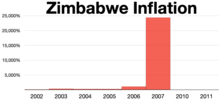

Hyperinflation in Zimbabwe is an ongoing period of currency instability in Zimbabwe which, using Cagan's definition of hyperinflation, began in February 2007. During the height of inflation from 2008 to 2009, it was difficult to measure Zimbabwe's hyperinflation because the government of Zimbabwe stopped filing official inflation statistics. However, Zimbabwe's peak month of inflation is estimated at 79.6 billion percent month-on-month, 89.7 sextillion () percent year-on-year in mid-November 2008.[1]
In April 2009, Zimbabwe stopped printing its currency, and currencies from other countries were used.[2] In mid-2015, Zimbabwe announced plans to have completely switched to the United States dollar by the end of that year.[3]
In June 2019, the Zimbabwean government announced the reintroduction of the Real Time Gross Settlement dollar (RTGS), to be known simply as the "Zimbabwe dollar", and that all foreign currency was no longer legal tender.[4] By mid-July 2019, inflation had increased to 175%, sparking concerns that the country was entering another period of hyperinflation.[5][6] In March 2020, with inflation above 500% annually, a new task force was created to assess the currency problems.[7][8] By July 2020, annual inflation was estimated to be 737%.[9]
- ^ "Hanke S., & Kwok, A. (2009) "On the Measurement of Zimbabwe's Hyperinflation", Cato Journal, 29 (2)" (PDF). Archived (PDF) from the original on 7 September 2019. Retrieved 11 July 2015.
- ^ "Zimbabwe Abandons Its Currency". BBC. 29 January 2009. Archived from the original on 5 September 2011. Retrieved 22 April 2011.
- ^ McGee, Patrick (12 June 2015). "Zimbabwe ditches its all but worthless currency". Financial Times. Archived from the original on 11 July 2015. Retrieved 2 February 2016.
- ^ Sguazzin, Anthony. "Zim's dollar returns, a decade after it became worthless". Fin24. Archived from the original on 24 June 2019. Retrieved 25 June 2019.
- ^ Samaita, Kevin (15 July 2019). "Zimbabwe's inflation doubles up to 175%". BusinessLIVE. Archived from the original on 16 July 2019. Retrieved 16 July 2019.
- ^ Muronzi, Chris (16 July 2019). "Could new figures forecast hyperinflation for Zimbabwe?". Al Jazeera. Archived from the original on 16 July 2019. Retrieved 16 July 2019.
- ^ Ndlovu, Ray; Goko, Colleen (11 March 2020). "Zimbabwe Turns to 'Task Force' in Bid to End Currency Rout". Bloomberg News. Archived from the original on 19 March 2020. Retrieved 19 March 2020.
- ^ "Government sets up currency stabilisation task force". The Herald. Harare, Zimbabwe. 11 March 2020. Archived from the original on 12 March 2020.
- ^ Ndlovu, Ray (14 July 2020). "Zimbabwe Steps Closer to Hyperinflation With 737.3% Annual Rate". Bloomberg L.P. Archived from the original on 14 July 2020. Retrieved 30 July 2020.
